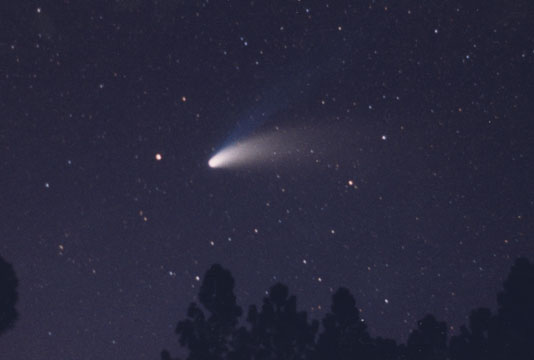
CURRENTLY OBSERVABLE COMETS

This page will list all the comets that I am currently observing, in west-to-east order from low in the western evening sky to low in the eastern morning sky. It will provide information about a comet's location and motion at the time of the update as well as a brief description of its recent behavior (and possible future behavior). The page will also list any asteroidal objects I am following that might potentially be comets, and for the benefit of comet observers in the southern hemisphere it will also list those comets (and other objects) that are bright enough for observation but that are not accessible from the northern hemisphere. Comets (and other objects) that are expected to be 9th magnitude or brighter (and that are also easily accessible for observation) at the time of the given update will be highlighted in red print. Orbital elements and ephemerides for the comets and other objects listed here can be obtained via the Minor Planet Center's Ephemeris service or via JPL Horizons.
Comet LINEAR C/2011 J2 (no. 521)
This distant comet just passed through perihelion a week ago. It is currently in northern circumpolar skies, presently at a declination of +79 degrees and located in western Cepheus 4 1/2 degrees east-northeast of the star Kappa Cephei; it is traveling towards the southeast at half a degree per day and passes 15 arcminutes southwest of the star 31 Cephei on January 12. The comet has appeared as a small and condensed object near magnitude 13 1/2 during my recent observations, and I don't expect much change during the coming weeks.
Comet 154P/Brewington (no. 530)
Having passed through perihelion a little less than three weeks ago, this comet has begun fading, and has appeared as a vague diffuse object near magnitude 11 1/2 during my most recent observations. It is currently located in eastern Pegasus 40 arcminutes east of the star 75 Pegasi and is traveling towards the east-northeast at close to 40 arcminutes per day, passing less than ten arcminutes north of the star Phi Pegasi on January 3 and crossing into southern Andromeda nine days later. I expect the comet to continue fading during the coming weeks, and I will probably lose it within about another month.
Comet Boattini C/2013 V1 (no. 536)
This relatively recent addition to my tally has brightened slightly since I first picked it up earlier this month, appearing as a small and somewhat condensed object slightly fainter than magnitude 13 1/2 when I observed it a few nights ago. It is located in northeastern Cetus 2 1/2 degrees southwest of the star Kappa Ceti and is presently traveling towards the northwest at 40 arcminutes per day, with this motion turning more northerly over the next few weeks; it passes 1 1/2 degrees east of the star Alpha Ceti on January 4 and crosses into southern Aries twelve days later. The comet was nearest Earth (1.47 AU) a week ago but is still almost four months away from perihelion passage, and thus I expect a slow and gradual brightening over the coming weeks.
Comet Siding Spring C/2013 A1 (no. 537)
My tally's most recent addition has appeared as a very faint and small object, slightly fainter than 14th magitude, during my initial observations over the past week. It is fairly deep in my southern sky at a declination of -39 degrees, being presently located in southeastern Fornax two degrees northwest of the star y Eridani and traveling slightly northward of due west at just under twenty arcminutes per day; it passes 1 1/2 degrees south of the galaxy NGC 1316 ("Fornax A") on January 5. I expect at most just a very slight brightening over the coming several weeks.
Comet 290P/Jager P/2013 N1 (no. 534)
This comet has brightened slightly since I first picked it up in early November, and appeared as a small and relatively condensed object slightly brighter than 14th magnitude when I observed it several nights ago. It just went through opposition three days ago and is nearest Earth (1.28 AU) on January 10 and, with perihelion passage 2 1/2 months away, is probably close to its maximum brightness; I expect at most just a very slight brightening over the next few weeks. The comet is located in east-central Auriga 1 1/2 degrees southwest of the star 51 Aurigae, and is traveling towards the southwest at 15 arcminutes per day.
Comet Nevski C/2013 V3 (no. 535)
I am probably finished with this comet; when I last observed it a few nights ago it appeared as an extremely vague, diffuse object of magnitude 11 1/2, indicating that the apparent outburst the comet underwent shortly after its discovery has now dispersed, and with its now being two months past perihelion passage there is no reason to expect to remain visually accessible. It is currently located in southern Ursa Major three degrees west of the star Nu Ursae Majoris and is traveling towards the north-northeast at just under 40 arcminutes per day.
Comet PANSTARRS C/2012 K1 (no. 525)
Following conjunction with the sun shortly after mid-November, this comet has now emerged into the morning sky, and has appeared near 13th magnitude ever since I picked it up in mid-December. It is currently located in southwestern Hercules 2 1/2 degrees east of the star 45 Serpentis, and is traveling towards the east-northeast at a relatively slow eight arcminutes per day. Now eight months away from perihelion passage, I expect the comet to brighten slowly over the coming weeks.
Comet LINEAR C/2012 X1 (no. 533)
The significant outburst that this comet underwent shortly after mid-October has now dispersed, but the comet itself continues to remain moderately bright, apppearing near 9th magnitude (and being faintly visible in binoculars) and exhibiting a distinct tail several arcminutes long telescopically, during my most recent observations. It is currently located in western Hercules 1 1/2 degrees west of the star 29 Herculis (and just over one degree northeast of the above comet) and is traveling slightly southward of due east at 45 arcminutes per day, crossing into northwestern Ophiuchus on January 8 and passing five arcminutes south of the star Kappa Ophiuchi two days later. The comet's recent behavior makes future brightness predictions a bit problematical, but since it is still almost two months away from perihelion passage it is reasonable to expect at least some gradual brightening over the next few weeks.
Comet Lovejoy C/2013 R1 (no. 532)
Having passed through perihelion just over a week ago, and being now over a month past its closest approach to Earth, this comet has faded some during recent weeks, although it remains an impressive binocular and telescopic object of 6th magnitude with a distinct tail one to two degrees long. It is currently located in western Hercules three degrees south of the star 73 Herculis, and is traveling towards the southeast at 40 arcminutes per day (decreasing to 30 arcminutes per day by mid-January); it crosses into northern Ophiuchus on January 14 and is at its minimum elongation (45 degrees) one day later. The comet should continue fading over the coming weeks as it recedes from the sun and Earth, although I expect it to remain a visually impressive object for at least a while longer.
SOUTHERN HEMISPHERE ONLY
Comet LINEAR C/2012 V2 [not observed]
Recent reports of this comet from the southern hemisphere have been rather spotty, but indicate that its current brightness is somewhere around 12th magnitude. It is located in southern circumpolar skies, currently at a declination of -65 degrees in western Triangulum Australe 2 1/2 degrees east of the star Alpha Circini; it is traveling slightly southward of due east at twenty arcminutes per day and passes five arcminutes north of Epsilon Trianguli Australis on January 9. The comet should continue fading, by perhaps half a magnitude or more by the latter part of January.
Return to "Counting Comets" main page